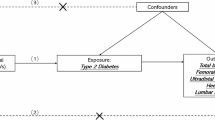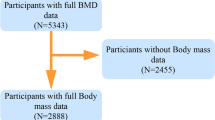Abstract
Body mass index (BMI) is closely associated with bone mineral density (BMD) in both men and women. However, the relationship between BMI and BMD varies according to different studies. Using SNPs strongly associated with BMI in 336,107 individuals, we conducted a two-sample Mendelian randomization study to identify whether and to what extent BMD at different skeletal sites was affected by BMI. A power calculation was also performed. We found that BMI may causally increase lumbar BMD (β 0.087; 95% CI 0.025 to 0.149; P = 0.006) and heel calcaneus BMD (β 0.120; 95% CI 0.082 to 0.157; P = 1 × 10–7). The associations of BMI with forearm and femoral neck BMD were not statistically significant. Our study suggested that higher BMI plays a causal role in increasing BMD and the effects are similar across the skeleton. BMI was causally and positively associated with lumbar and heel calcaneus BMD. However, no statistically significant effects were observed for BMI on femoral neck or forearm BMD.

Similar content being viewed by others
Data Availability
All data we used in the study was available at MR-Base platform.
References
Burge R, Dawson-Hughes B, Solomon DH, Wong JB, King A et al (2007) Incidence and economic burden of osteoporosis-related fractures in the United States, 2005–2025. J Bone Miner Res 22:465–475
Wright NC, Looker AC, Saag KG, Curtis JR, Delzell ES et al (2014) The recent prevalence of osteoporosis and low bone mass in the United States based on bone mineral density at the femoral neck or lumbar spine. J Bone Miner Res 29:2520–2526
Peacock M, Turner CH, Econs MJ, Foroud T (2002) Genetics of osteoporosis. Endocr Rev 23:303–326
Palermo A, Tuccinardi D, Defeudis G, Watanabe M, D'Onofrio L et al (2016) BMI and BMD: the potential interplay between obesity and bone fragility. Int J Environ Res Public Health 13:544
Greco EA, Fornari R, Rossi F, Santiemma V, Prossomariti G et al (2010) Is obesity protective for osteoporosis? Evaluation of bone mineral density in individuals with high body mass index. Int J Clin Pract 64:817–820
Jankowska EA, Rogucka E, Medras M (2001) Are general obesity and visceral adiposity in men linked to reduced bone mineral content resulting from normal ageing? A population-based study. Andrologia 33:384–389
Ravn P, Cizza G, Bjarnason NH, Thompson D, Daley M et al (1999) Low body mass index is an important risk factor for low bone mass and increased bone loss in early postmenopausal women. Early Postmenopausal Intervention Cohort (EPIC) study group. J Bone Miner Res 14:1622–1627
Edelstein SL, Barrett-Connor E (1993) Relation between body size and bone mineral density in elderly men and women. Am J Epidemiol 138:160–169
De Laet C, Kanis JA, Oden A, Johanson H, Johnell O et al (2005) Body mass index as a predictor of fracture risk: a meta-analysis. Osteoporos Int 16:1330–1338
Roy DK, O'Neill TW, Finn JD, Lunt M, Silman AJ et al (2003) Determinants of incident vertebral fracture in men and women: results from the European Prospective Osteoporosis Study (EPOS). Osteoporos Int 14:19–26
Mahajan R, Stokes M, Elliott A, Munawar DA, Khokhar KB et al (2020) Complex interaction of obesity, intentional weight loss and heart failure: a systematic review and meta-analysis. Heart (British Cardiac Society) 106:58–68
Yeh T-L, Chen H-H, Tsai S-Y, Lin C-Y, Liu S-J et al (2019) The relationship between metabolically healthy obesity and the risk of cardiovascular disease: a systematic review and meta-analysis. J Clin Med 8:1228
Davies NM, Holmes MV, Smith GD (2018) Reading Mendelian randomisation studies: a guide, glossary, and checklist for clinicians. BMJ 362:k601
Smith GD, Ebrahim S (2004) Mendelian randomization: prospects, potentials, and limitations. Int J Epidemiol 33:30–42
Zheng H-F, Forgetta V, Hsu Y-H, Estrada K, Rosello-Diez A et al (2015) Whole-genome sequencing identifies EN1 as a determinant of bone density and fracture. Nature 526:112–117
Kemp JP, Morris JA, Medina-Gomez C, Forgetta V, Warrington NM et al (2017) Identification of 153 new loci associated with heel bone mineral density and functional involvement of GPC6 in osteoporosis. Nat Genet 49:1468
Hemani G, Zheng J, Elsworth B, Wade KH, Haberland V et al (2018) The MR-base platform supports systematic causal inference across the human phenome. eLife 7:e34408
Genomes Project Consortium (2015) A global reference for human genetic variation. Nature 526:68–74
Hartwig FP, Davies NM, Hemani G, Smith GD (2016) Two-sample Mendelian randomization: avoiding the downsides of a powerful, widely applicable but potentially fallible technique. Int J Epidemiol 45:1717–1726
Burgess S, Butterworth A, Thompson SG (2013) Mendelian randomization analysis with multiple genetic variants using summarized data. Genet Epidemiol 37:658–665
Bowden J, Smith GD, Haycock PC, Burgess S (2016) Consistent estimation in mendelian randomization with some invalid instruments using a weighted median estimator. Genet Epidemiol 40:304–314
Bowden J, Smith GD, Burgess S (2015) Mendelian randomization with invalid instruments: effect estimation and bias detection through Egger regression. Int J Epidemiol 44:512–525
Brion M-J, Shakhbazov K, Visscher PM (2013) Calculating statistical power in Mendelian randomization studies. Int J Epidemiol 42:1497–1501
Burgess S, Thompson SG (2017) Interpreting findings from Mendelian randomization using the MR-Egger method. Eur J Epidemiol 32:377–389
Ribot C, Trémollières F, Pouillès J-M (1994) The effect of obesity on postmenopausal bone loss and the risk of osteoporosis. In: Draper HH (ed) Nutrition and osteoporosis. Springer, Boston, pp 257–271
Ribot C, Tremollieres F, Pouilles JM, Bonneu M, Germain F et al (1987) Obesity and postmenopausal bone loss: the influence of obesity on vertebral density and bone turnover in postmenopausal women. Bone 8:327–331
Morin S, Tsang JF, Leslie WD (2009) Weight and body mass index predict bone mineral density and fractures in women aged 40 to 59 years. Osteoporos Int 20:363–370
Wiacek M, Skrzek A, Ignasiak Z, Zubrzycki IZ (2010) The changes of bone mineral density in relation to body mass index and aging among Polish and different ethnic women in the United States: cross-sectional studies. J Clin Densitom 13:307–314
Babaroutsi E, Magkos F, Manios Y, Sidossis LS (2005) Body mass index, calcium intake, and physical activity affect calcaneal ultrasound in healthy Greek males in an age-dependent and parameter-specific manner. J Bone Miner Metab 23:157–166
Saarelainen J, Kiviniemi V, Krger H, Tuppurainen M, Niskanen L et al (2012) Body mass index and bone loss among postmenopausal women: the 10-year follow-up of the OSTPRE cohort. J Bone Miner Metab 30:208–216
Yang TL, Zhao LJ, Liu YJ, Liu JF, Recker RR et al (2006) Genetic and environmental correlations of bone mineral density at different skeletal sites in females and males. Calcif Tissue Int 78:212–217
Johansson H, Kanis JA, Odén A, McCloskey E, Chapurlat RD et al (2014) A meta-analysis of the association of fracture risk and body mass index in women. J Bone Miner Res 29:223–233
Cao JJ (2011) Effects of obesity on bone metabolism. J Orthop Surg Res 6:30
Hotamisligil GS (2006) Inflammation and metabolic disorders. Nature 444:860–867
Watts NB, Glow investigators (2014) Insights from the global longitudinal study of osteoporosis in women (GLOW). Nat Rev Endocrinol 10:412–422
Prieto-Alhambra D, Premaor MO, Aviles FF, Hermosilla E, Martinez-Laguna D et al (2012) The association between fracture and obesity is site-dependent: a population-based study in postmenopausal women. J Bone Miner Res 27:294–300
Lawlor DA, Tilling K, Smith GD (2016) Triangulation in aetiological epidemiology. Int J Epidemiol 45:1866–1886
Acknowledgementss
We thank the developers of MR-Base platform.
Funding
This study was partially supported by the Fundamental Research Funds for the Central Universities (xyz022019043) and Key Research and Development Program of Shaanxi Province (2018SF-186).
Author information
Authors and Affiliations
Corresponding author
Ethics declarations
Conflict of interest
Jidong Song, Rupeng Zhang, Leifeng Lv, Jialin Liang, Wei Wang, Ruiyu Liu and Xiaoqian Dang have no financial interests to disclose.
Human and Animal Rights and Informed Consent
All participants of the original studies included in the GWASs had provided informed consent.
Additional information
Publisher's Note
Springer Nature remains neutral with regard to jurisdictional claims in published maps and institutional affiliations.
Electronic supplementary material
Below is the link to the electronic supplementary material.
Rights and permissions
About this article
Cite this article
Song, J., Zhang, R., Lv, L. et al. The Relationship Between Body Mass Index and Bone Mineral Density: A Mendelian Randomization Study. Calcif Tissue Int 107, 440–445 (2020). https://doi.org/10.1007/s00223-020-00736-w
Received:
Accepted:
Published:
Issue Date:
DOI: https://doi.org/10.1007/s00223-020-00736-w




